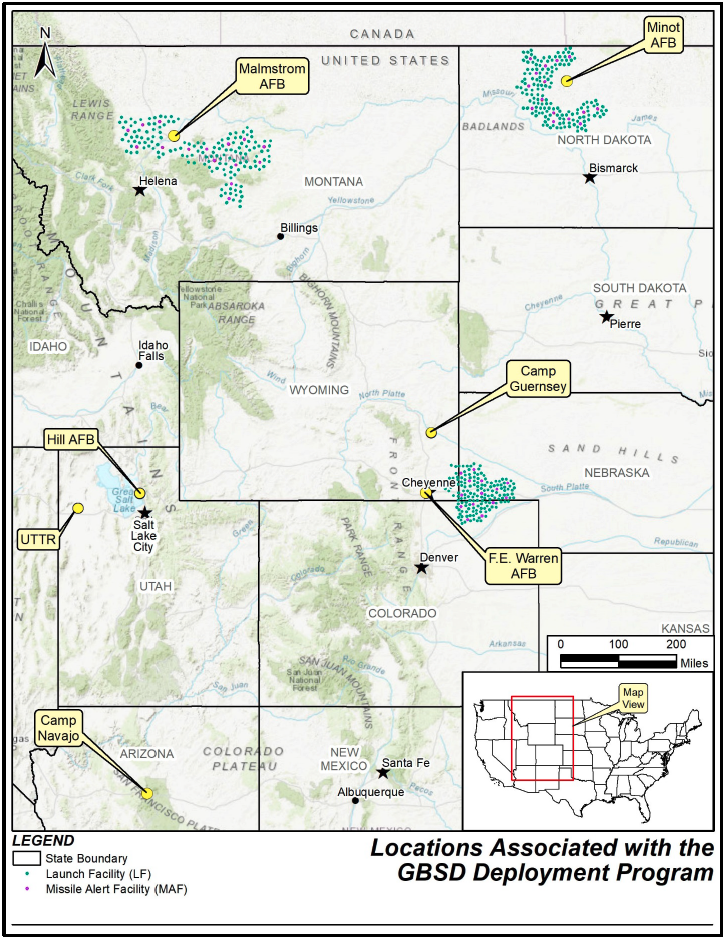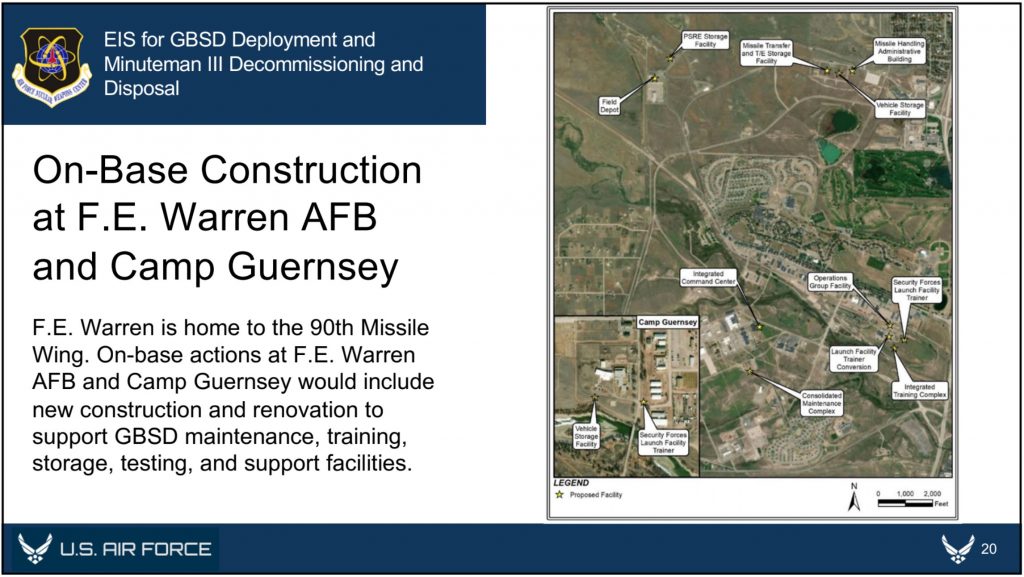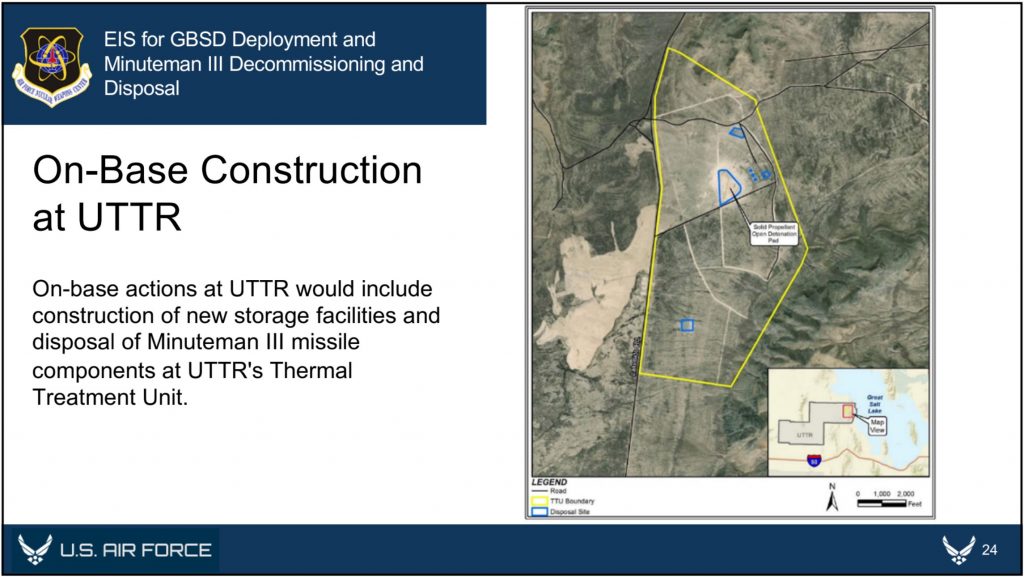Flying Under The Radar: A Missile Accident in South Asia
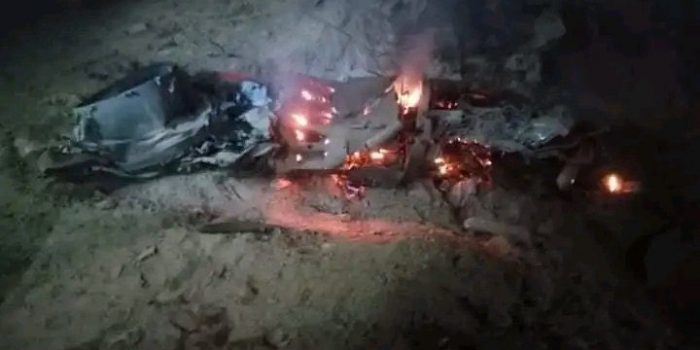
A crashed Indian missile inside Pakistani territory. Image: Pakistan Air Force.
With all eyes turned towards Ukraine these past weeks, it was easy to miss what was almost certainly a historical first: a nuclear-armed state accidentally launching a missile at another nuclear-armed state.*
On the evening of March 9th, during what India subsequently called “routine maintenance and inspection,” a missile was accidentally launched into the territory of Pakistan and impacted near the town of Mian Channu, slightly more than 100 kilometers west of the India-Pakistan border.
Because much of the world’s attention has understandably been focused on Eastern Europe, this story is not getting the attention that it deserves. However, it warrants very serious scrutiny––not only due to the bizarre nature of the accident itself, but also because both India’s and Pakistan’s reactions to the incident reveal that crisis stability between South Asia’s two nuclear rivals may be much less stable than previously believed.
The Incident
Using official statements and open-source clues, it is possible to piece together a relatively complete picture of what took place on the evening of March 9th.
At 18:43:43 Pakistan Standard Time (19:13:43 India Standard Time), the Pakistan Air Force picked up a “high-speed flying object” 104 kilometers inside Indian territory, near Sirsa, in the state of Haryana. According Air Vice Marshal Tariq Zia––the Director General Public Relations for the Pakistan Air Force––the object traveled in a southwesterly direction at a speed between Mach 2.5 and Mach 3. After traveling between 70 and 80 kilometers, the object turned northwest and crossed the India-Pakistan border at 18:46:45 PKT. The object then continued on the same northwesterly trajectory until it crashed near the Pakistani town of Mian Channu at 18:50:29 PKT.
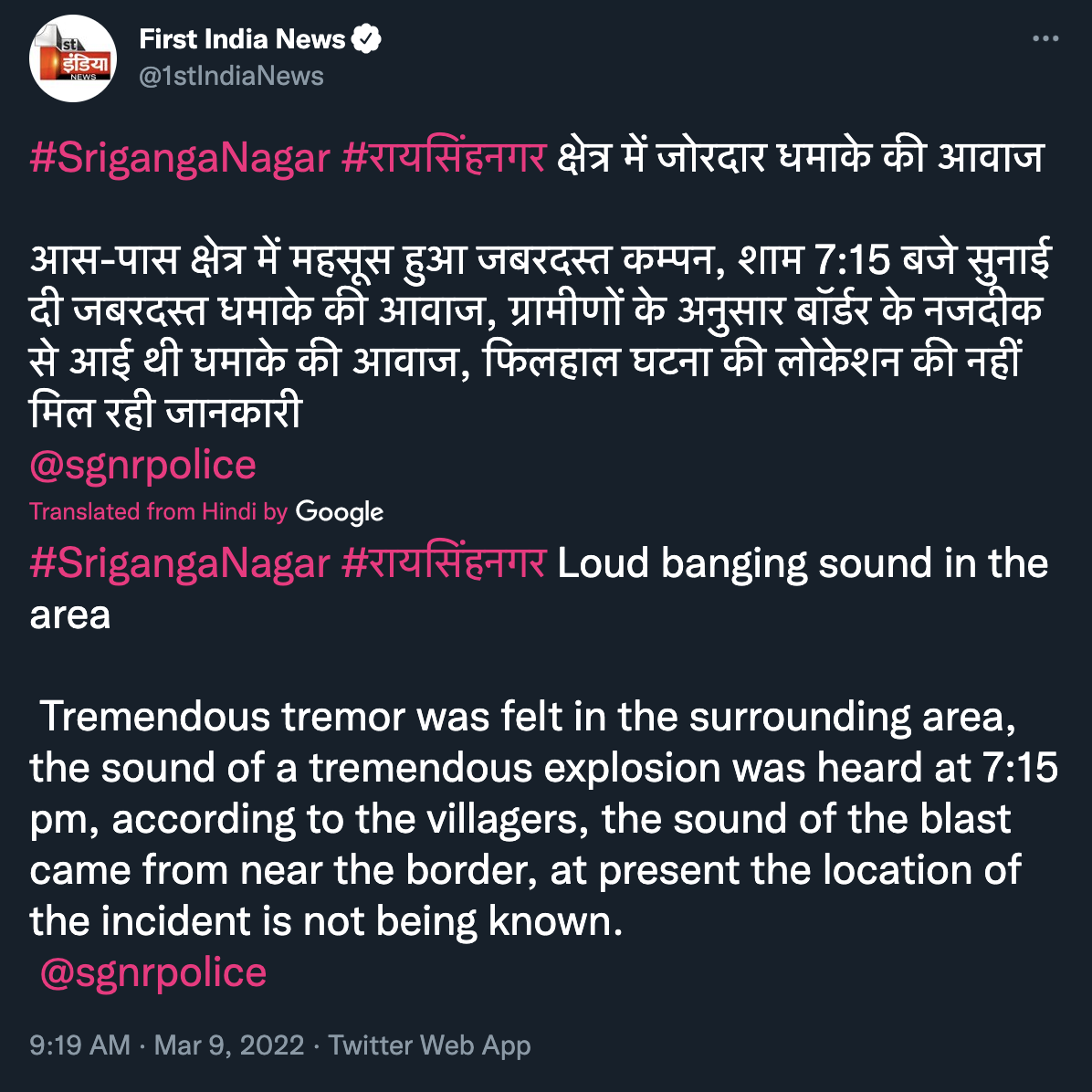
Tweet from @1stIndiaNews indicating that a “tremendous explosion” was heard at approximately 19:15 IST at the city of Sri Ganganagar near the India-Pakistan border. This time and location adds a data point to interpreting the flight path of the missile.
According to Pakistani military officials in a March 10th press conference, 3 minutes and 46 seconds of the object’s total flight time of 6 minutes and 46 seconds were within Pakistani airspace, and the total distance traveled inside of Pakistan was 124 kilometers.

Annotated map of the missile’s flight path provided by Pakistani military officials to media on 10 March 2022.
In a press conference, Pakistani military officials stated that the object was “certainly unarmed” and that no one was injured, although noted that it damaged “civilian property.”
Although the crash site has not been confirmed and official photos include very few useful visual signatures, observation of local civilian social media activity indicates that a likely candidate is the Bakhshu Makhan Hotel, just outside of Mian Channu (30°27’6.40″N, 72°24’10.87″E). One video of the crash site posted to Twitter includes a shot of a uniquely-colored blue building with a white setback roof on the other side of a divided highway. At least two vertical poles can be seen on the roof of the building. All of these signatures appear to match those included in images of the Bakhshu Makhan Hotel in Google Images.
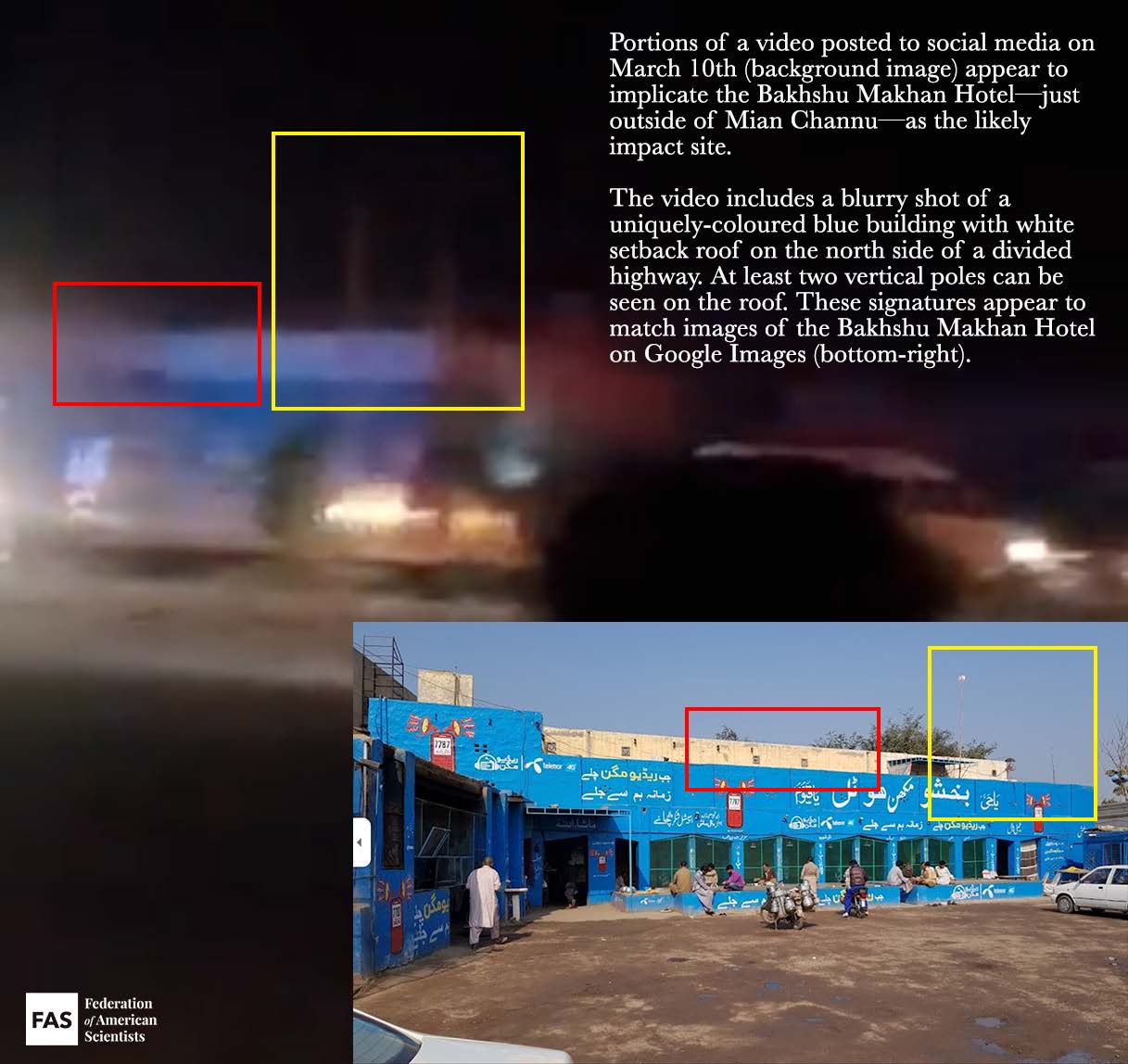
The video’s caption suggests that the object that crashed was an “army aviation aircraft drone;” however, Pakistani military officials subsequently reported that the object was an Indian missile. Neither Pakistan nor India has publicly confirmed what type of missile it was; however, in a March 10th press conference, Pakistani military officials stated that “we can so far deduce that it was a supersonic missile––an unknown missile––and it was launched from the ground, so it was a surface-to-surface missile.”
This statement, in addition to photos of the debris and other official details relating to range, speed, altitude, and flight time of the object, suggest that it was very likely a BrahMos cruise missile.
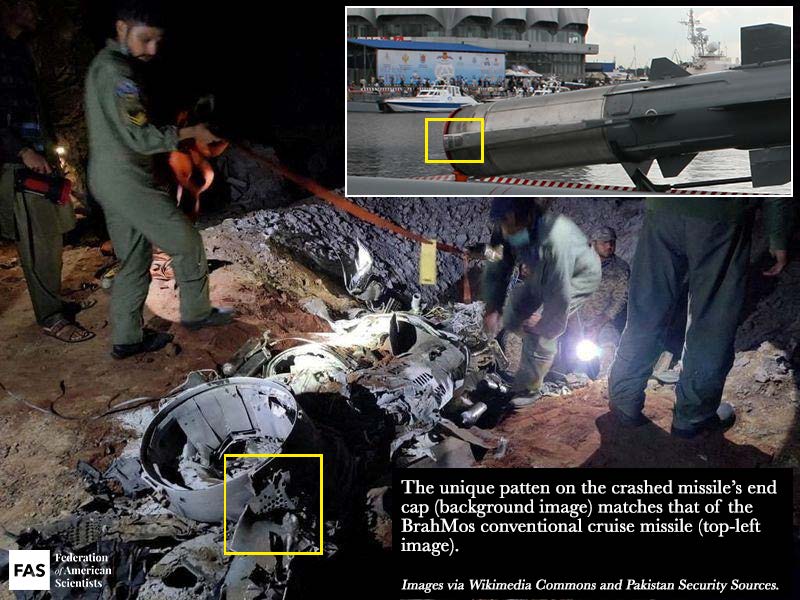
BrahMos is a ramjet-powered, supersonic cruise missile co-developed with Russia, that can be launched from land, sea, and air platforms and can travel at a speed of approximately March 2.8. The US National Air and Space Intelligence Centre (NASIC) suggested that an earlier version of BrahMos had a range of “less than 300” kilometers, but the Indian Ministry of Defence recently announced on 20 January 2022 that it had extended the BrahMos’ range, with defence sources saying that the missile could now travel over 500 kilometres. The reported speed of the “high-speed flying object,” as well as the distance traveled, matches the publicly-known capabilities of the BrahMos cruise missile.
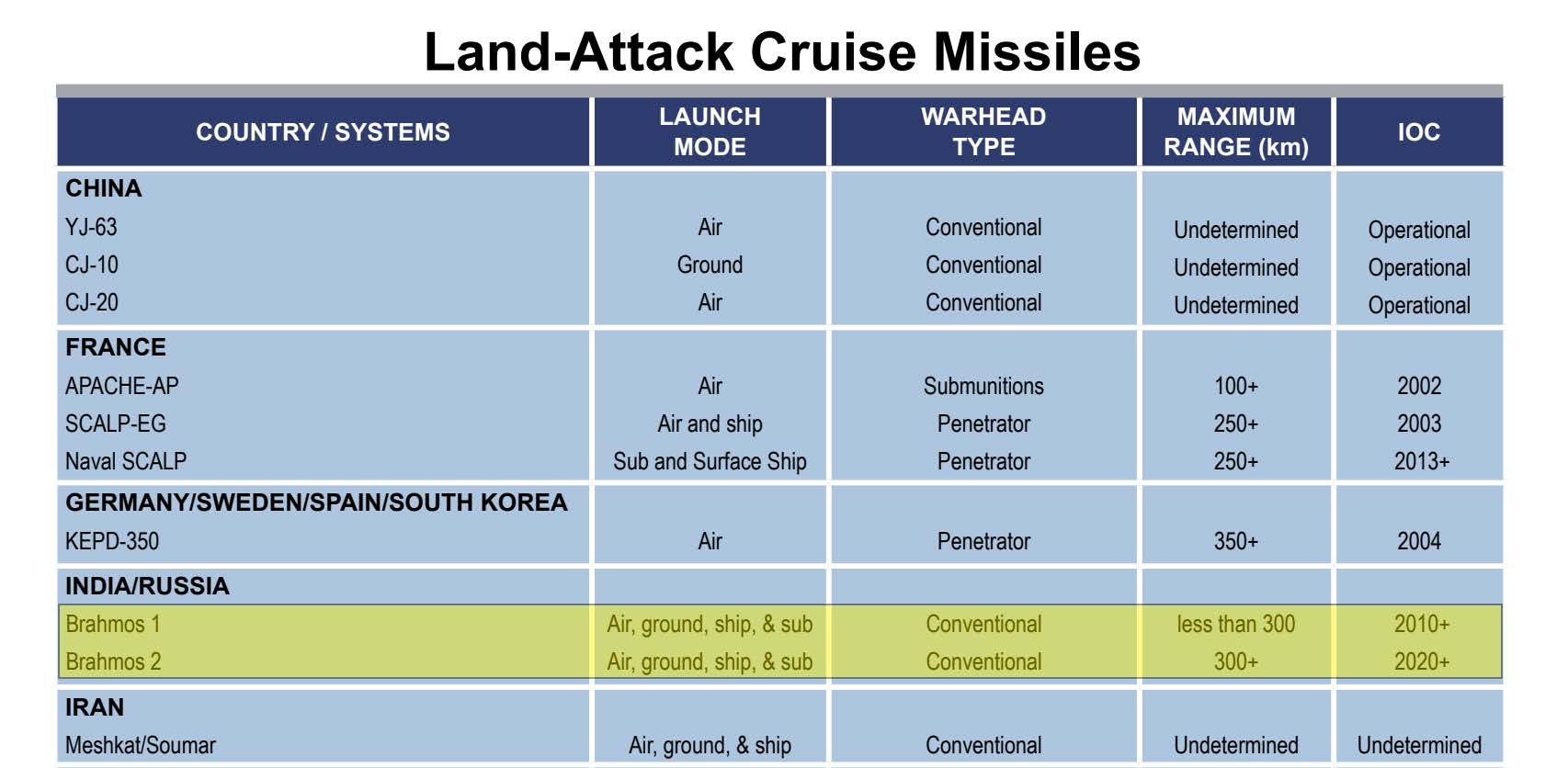
The National Air and Space Intelligence Center’s 2017 Ballistic and Cruise Missile report lists two versions of the BrahMos missile as “conventional.”
Although many Indian media outlets often describe the BrahMos as a nuclear or dual-capable system, NASIC lists it as “conventional,” and there is no public evidence to indicate that the missile can carry nuclear weapons.
India has launched a Court of Inquiry to determine how the incident occurred; however, the Indian government has otherwise remained tight-lipped on details. In the absence of official statements, small snippets have trickled out through Indian and Pakistani media sources––prompting several questions that still need answers.
How did the missile get “accidentally” launched?
According to the Times of India, an audit was being conducted by the Indian Air Force’s Directorate of Air Staff Inspection at the time of the launch. As part of that audit, or possibly as part of a separate exercise, it appears that target coordinates––including mid-flight waypoints––were fed into the missile’s guidance system. According to Indian defence sources, in order to launch the BrahMos, the missile’s mechanical and software safety locks would also have had to be bypassed and the launch codes would have had to be entered into the system.
The BrahMos does not appear to have a self-destruct mechanism. As a result, once the missile was launched, there was no way to abort.
Given that defence sources indicate that the missile “was certainly not meant to be launched,” it still remains unclear whether the launch was due to human or technical error. On March 11th, in its first public statement about the incident, the Indian government stated that “a technical malfunction led to the accidental firing of a missile.” However, since the formal convening of a Court of Inquiry, the government has since changed its rhetoric, with Indian officials stating that “the accidental firing took place because of human error. That’s what has emerged at this stage of the inquiry. There were possible lapses on the part of a Group Captain and a few others.” Tribute India reports that there are currently four individuals under investigation.
While this is certainly a plausible explanation for the incident, it is also worth noting that the Indian government would be financially incentivized to emphasize the human error narrative over a technical malfunction narrative. On January 28th, India concluded a $374.96 million deal with the Philippines to export the BrahMos––a deal which amounts to the country’s largest defence export contract. Additional BrahMos exports will be crucial for India to meet its ambitious defence export targets by 2025, and the negative publicity associated with a possible BrahMos technical malfunction could significantly hinder that goal.
Did Pakistan track the missile correctly?
In a press conference on March 10th, Pakistani military officials noted that Pakistan’s “actions, response, everything…it was perfect. We detected it on time, and we took care of it.” However, Indian military officials have publicly disputed Pakistan’s interpretation of the missile’s flight path. Pakistan announced on March 10th that the missile was picked up near Sirsa; however, Indian officials subsequently stated that the missile was launched from a location near Ambala Air Force Station, nearly 175 kilometers away. India’s explanation is likely to be more accurate, given that there is no known BrahMos base near Sirsa, but there is one near Ambala (h/t @tinfoil_globe). Indian defence sources have also suggested that the map of the missile’s perceived trajectory that the Pakistani military released on March 10th was incorrect.
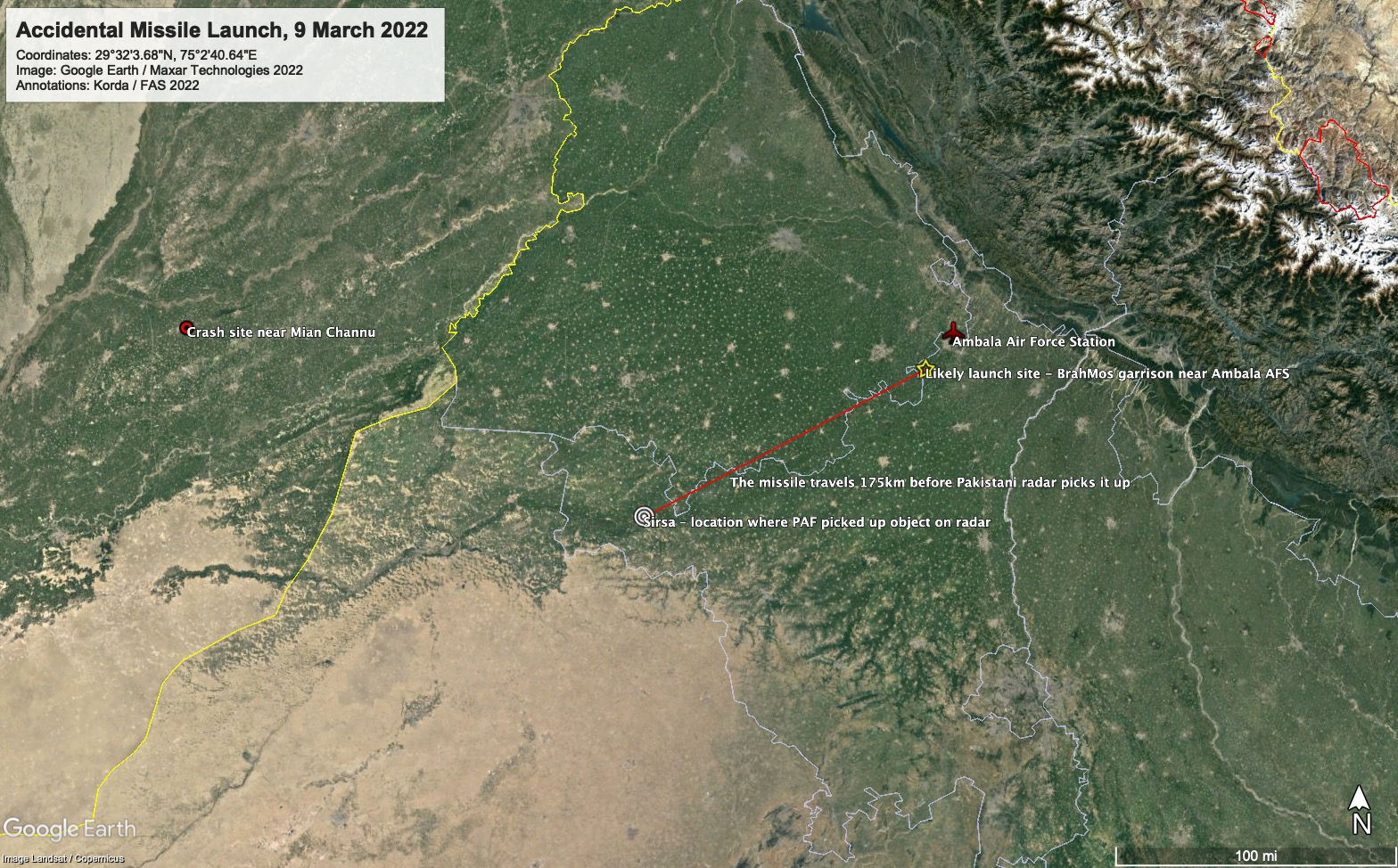
Annotated Google Earth image showing the 175 kilometer distance between the likely launch site and Pakistan’s radar pickup.
Furthermore, Pakistani officials announced on March 10th that the missile’s original destination was likely to be the Mahajan Field Firing Range in Rajasthan, before it suddenly turned and headed northwest into Pakistan. However, Indian defence sources have since suggested that the missile was not actually headed for the Mahajan Field Firing Range, but instead was “follow[ing] the trajectory that it would have in case of a conflict, but ‘certain factors’ played a role in ensuring that any pre-fed target was out of danger.” Given that the impact site was not near any critical military or political infrastructure, this could suggest that the cruise missile had its wartime mid-flight trajectory waypoints pre-loaded into the system, but its actual target had not yet been selected. If this is the case, then this targeting practice would be similar in nature to how some other nuclear-armed states target their missiles at the open ocean during peacetime––precisely in case of incidents like this one. Although the missile still landed on Pakistani territory, the fact that it did not hit any critical targets prevented the crisis from escalating. It is worth noting, however, that this would certainly not be the case if the missile had actually injured or killed anyone.
During the March 10th press conference, Pakistani officials noted that the Pakistan Air Force did not attempt to shoot down the missile because “the measures in place in times of war or in times of escalation are different [from those] in peace time.” However, India’s challenges to Pakistan’s narrative also raise significant questions about whether the Pakistan Air Force was able to accurately track the missile correctly. If not, then this raises the possibility of miscalculation or miscommunication, and crisis stability would be seriously eroded if a similar situation occurred during a time of heightened tensions.
Were any civilian aircraft put in danger?
In its public statements, Pakistan has emphasized that the accidental missile launch could have put civilian flights in danger, as India did not issue a Notice to Airmen (NOTAM) prior to launch. Governments typically issue NOTAMs in conjunction with missile tests, in order to inform civilian aircraft to avoid a particular patch of airspace during the launch window. Given that India did not issue one, a time-lapse video prepared by Flightradar24 showed that there were several civilian flights passing very close to the missile’s flight path at the time of launch. The video erroneously suggests that the missile traveled in a straight line from Ambala to Mian Channu, when it appears to have dog-legged in mid-flight; however, the video is still a useful resource to demonstrate how crowded the skies were at the time of the accident.
A screenshot of a video prepared by Flightradar24, showing that there were several civilian flights passing very close to the missile’s flight path at the time of launch.
Why was India’s response so poor?
Given the seriousness of the incident, India’s delayed response has been particularly striking. Immediately following the accidental launch, India could have alerted Pakistan using its high-level military hotlines; however, Pakistani officials stated that it did not do so. Additionally, India waited two days after the incident before issuing a short public statement.
India’s poor response to this unprecedented incident has serious implications for crisis stability between the two countries. According to DNA India, in the absence of clarification from India, Pakistan Air Force’s Air Defence Operations Centre immediately suspended all military and civilian aircraft for nearly six hours, and reportedly placed frontline bases and strike aircraft on high alert. Defence sources stated that these bases remained on alert until 13:00 PKT on March 14th. Pakistani officials appeared to confirm this, noting that “whatever procedures were to start, whatever tactical actions had to be taken, they were taken.”
We were very, very lucky
Thankfully, this incident took place during a period of relative peacetime between the two nuclear-armed countries. However, in recent years India and Pakistan have openly engaged in conventional warfare in the context of border skirmishes. In one instance, Pakistani military officials even activated the National Command Authority––the mechanism that directs the country’s nuclear arsenal––as a signal to India. At the time, the spokesperson of the Pakistan Armed Forces not-so-subtly told the media, “I hope you know what the NCA means and what it constitutes.”
If this same accidental launch had taken place during the 2019 Balakot crisis, or a similar incident, India’s actions were woefully deficient and could have propelled the crisis into a very dangerous phase.
Furthermore, as we have written previously, in recent years India’s rocket forces have increasingly worked to “canisterize” their missiles by storing them inside sealed, climate-controlled tubes. In this configuration, the warhead can be permanently mated with the missile instead of having to be installed prior to launch, which would significantly reduce the amount of time needed to launch nuclear weapons in a crisis.
This is a new feature of India’s Strategic Forces Command’s increased emphasis on readiness. In recent years, former senior civilian and military officials have reportedly suggested in interviews that “some portion of India’s nuclear force, particularly those weapons and capabilities designed for use against Pakistan, are now kept at a high state of readiness, capable of being operationalized and released within seconds or minutes in a crisis—not hours, as had been assumed.”
This would likely cause Pakistan to increase the readiness of its missiles as well and shorten its launch procedures––steps that could increase crisis instability and potentially raise the likelihood of nuclear use in a regional crisis. As Vipin Narang and Christopher Clary noted in a 2019 article for International Security, this development “enables India to possibly release a full counterforce strike with few indications to Pakistan that it was coming (a necessary precondition for success). If Pakistan believed that India had a ‘comprehensive first strike’ strategy and with no indication of when a strike was coming, crisis instability would be amplified significantly.”
India’s recent missile accident––and the deficient political and military responses from both parties––suggests that regional crisis instability is less stable than previously assumed. To that end, this crisis should provide an opportunity for both India and Pakistan to collaboratively review their communications procedures, in order to ensure that any future accidents prompt diplomatic responses, rather than military ones.
Background Information:
- “Indian Nuclear Forces, 2020,” FAS Nuclear Notebook, Bulletin of the Atomic Scientists, July/August 2020.
- “Pakistan Nuclear Weapons, 2021,” FAS Nuclear Notebook, Bulletin of the Atomic Scientists, Sept/Oct 2021.
- “India’s Nuclear Arsenal Takes A Big Step Forward,” FAS Strategic Security Blog, Dec 2021.
- Status of World Nuclear Forces, Federation of American Scientists
This article was made possible with generous support from the John D. and Catherine T. MacArthur Foundation, the New-Land Foundation, the Prospect Hill Foundation, and the Ploughshares Fund. The statements made and views expressed are solely the responsibility of the author.
*[Note: This type of missile accident has apparently happened before; on 11 September 1986, a Soviet missile flew more than 1,500 off-course and landed in China. Thank you to the excellent Stephen Schwartz for the historical reference.]
Categories: Arms Control, ballistic missiles, Deterrence, Disarmament, India, Nuclear Weapons, Pakistan
India’s Nuclear Arsenal Takes A Big Step Forward
On 18 December 2021, India tested its new Agni-P medium-range ballistic missile from its Integrated Test Range on Abdul Kalam Island. This was the second test of the missile, the first test having been conducted in June 2021.
Our friends at Planet Labs PBC managed to capture an image of the Agni-P launcher sitting on the launch pad the day before the test took place.
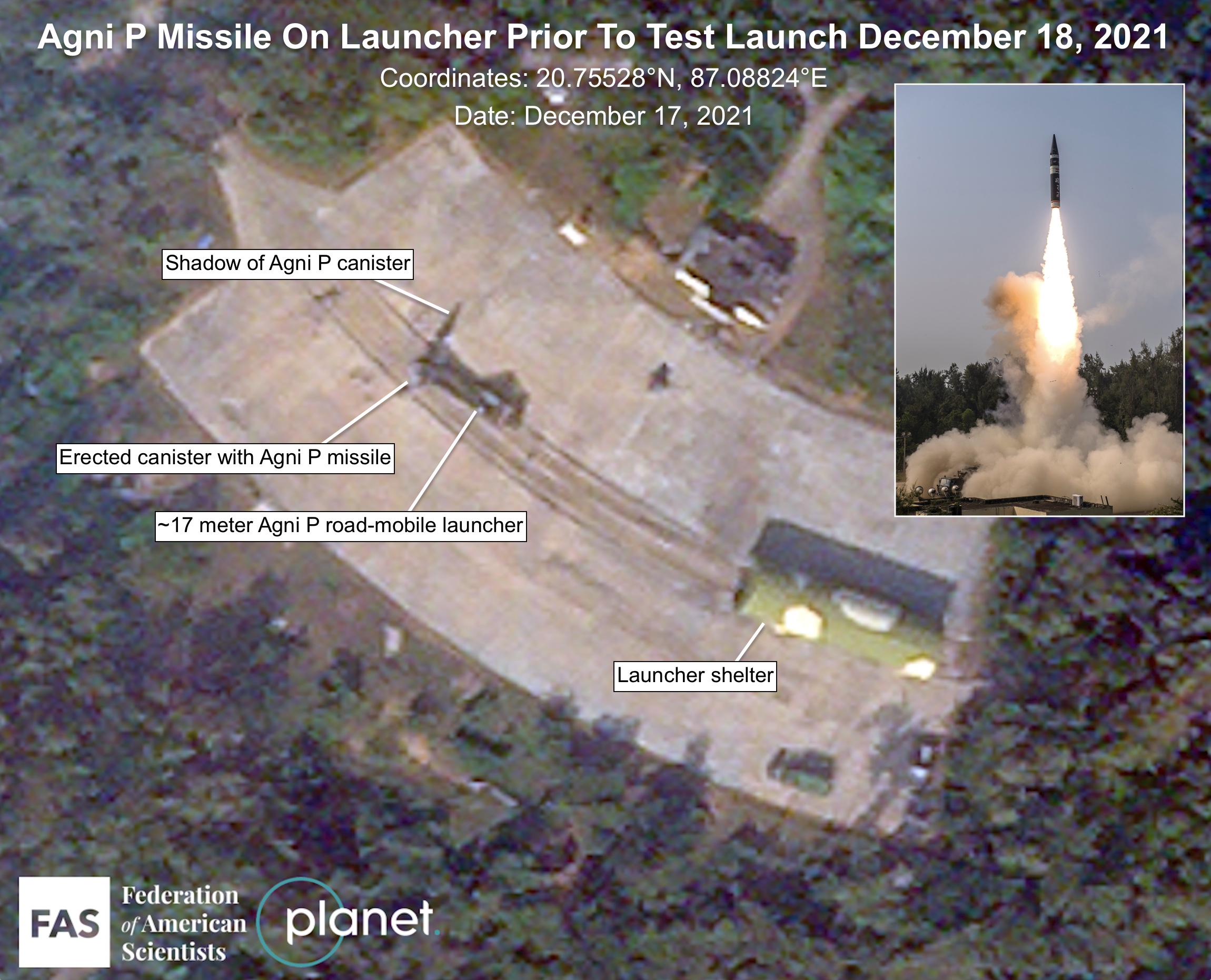
Following both launches of the Agni-P, the Indian Government referred to the missile as a “new generation” nuclear-capable ballistic missile. Back in 2016, when the Defence Research and Development Organisation (DRDO) first announced the development of the Agni-P (which was called the Agni-1P at the time), a senior DRDO official explained why this missile was so special:
“As our ballistic missiles grew in range, our technology grew in sophistication. Now the early, short-range missiles, which incorporate older technologies, will be replaced by missiles with more advanced technologies. Call it backward integration of technology.”
The Agni-P is India’s first shorter-range missile to incorporate technologies now found in the newer Agni-IV and -V ballistic missiles, including more advanced rocket motors, propellants, avionics, and navigation systems.
Most notably, the Agni-P also incorporates a new feature seen on India’s new Agni-V intermediate-range ballistic missiles that has the potential to impact strategic stability: canisterization. And the launcher used in the Agni-P launch appears to have increased mobility. There are also unconfirmed rumors that the Agni-P and Agni-V might have the capability to launch multiple warheads.
Canisterization
“Canisterizing” refers to storing missiles inside a sealed, climate-controlled tube to protect them from the outside elements during transportation. In this configuration, the warhead can be permanently mated with the missile instead of having to be installed prior to launch, which would significantly reduce the amount of time needed to launch nuclear weapons in a crisis. This is a new feature of India’s Strategic Forces Command’s increased emphasis on readiness. In recent years, former senior civilian and military officials have reportedly suggested in interviews that “some portion of India’s nuclear force, particularly those weapons and capabilities designed for use against Pakistan, are now kept at a high state of readiness, capable of being operationalized and released within seconds or minutes in a crisis—not hours, as had been assumed.”
If Indian warheads are increasingly mated to their delivery systems, then it would be harder for an adversary to detect when a crisis is about to rise to the nuclear threshold. With separated warheads and delivery systems, the signals involved with mating the two would be more visible in a crisis, and the process itself would take longer. But widespread canisterization with fully armed missiles would shorten warning time. This would likely cause Pakistan to increase the readiness of its missiles as well and shorten its launch procedures––steps that could increase crisis instability and potentially raise the likelihood of nuclear use in a regional crisis. As Vipin Narang and Christopher Clary noted in a 2019 article for International Security, this development “enables India to possibly release a full counterforce strike with few indications to Pakistan that it was coming (a necessary precondition for success). If Pakistan believed that India had a ‘comprehensive first strike’ strategy and with no indication of when a strike was coming, crisis instability would be amplified significantly.”
For years, it was evident that India’s new Agni-V intermediate-range missile (the Indian Ministry of Defense says Agni-V has a range of up to 5,000 kilometers; the US military says the range is over 5,000 kilometers but not ICBM range) would be canisterized; however, the introduction of the shorter-range, canisterized Agni-P suggests that India ultimately intends to incorporate canisterization technology across its suite of land-based nuclear delivery systems, encompassing both shorter- and longer-range missiles. While Agni-V is a new addition to India’s arsenal, Arni-P might be intended––once it becomes operational––to replace India’s older Agni-I and Agni-II systems.
MIRV technology
It appears that India is also developing technology to potentially deploy multiple warheads on each missile. There is still uncertainty about how advanced this technology is and whether it would enable independent targeting of each warhead (using multiple independently-targetable reentry vehicles, or MIRVs) or simply multiple payloads against the same target.
The Agni-P test in June 2021 was rumored to have used two maneuverable decoys to simulate a MIRVed payload, with unnamed Indian defense sources suggesting that a functional MIRV capability will take another two years to develop and flight-test. The Indian MOD press release did not mention payloads. It is unclear whether the December 2021 test utilized decoys in a similar manner.
In 2013, the director-general of DRDO noted in an interview that “Our design activity on the development and production of MIRV is at an advanced stage today. We are designing the MIRVs, we are integrating [them] with Agni IV and Agni V missiles.” In October 2021, the Indian Strategic Forces Command conducted its first user trial of the Agni-V in full operational configuration, which was rumored to have tested MIRV technology. The MOD press release did not mention MIRVs.
If India succeeds in developing an operational MIRV capability for its ballistic missiles, it would be able to strike more targets with fewer missiles, thus potentially exacerbating crisis instability with Pakistan. If either country believed that India could potentially conduct a decapitating or significant first strike against Pakistan, a serious crisis could potentially go nuclear with little advance warning. Indian missiles with MIRVs would become more important targets for an adversary to destroy before they could be launched to reduce the damage India could inflict. Additionally, India’s MIRVs might prompt Indian decision-makers to try and preemptively disarm Pakistan in a crisis.
India’s other nuclear adversary, China, has already developed MIRV capability for some of its long-range missiles and is significantly increasing its nuclear arsenal, which might be a factor in India’s pursuit of MIRV technology. A MIRV race between the two countries would have significant implications for nuclear force levels and regional stability. For India, MIRV capability would allow it to more rapidly increase its nuclear stockpile in the future, if it so decided––especially if its plutonium production capability can make use of the unsafeguarded breeder reactors that are currently under construction.
Implications for India’s nuclear policy
India has long adhered to a nuclear no-first-use (NFU) policy and in 2020 India officially stated that there has been no change in its NFU policy. Moreover, the Agni-V test launch in October 2021 was accompanied by a reaffirmation of a “’credible minimum deterrence’ that underpins the commitment to ‘No First Use’.”
At the same time, however, the pledge to NFU has been caveated, watered-down, and called into question by government statements and recent scholarship. The increased readiness and pursuit of MIRV capability for India’s strategic forces could further complicate India’s adherence to its NFU policy and could potentially cause India’s nuclear adversaries to doubt its NFU policy altogether.
Given that Indian security forces have repeatedly clashed with both Pakistani and Chinese troops during recent border disputes, potentially destabilizing developments in India’s nuclear arsenal should concern all those who want to keep regional tensions below boiling point.
Background Information:
- “Indian Nuclear Forces, 2020,” FAS Nuclear Notebook, Bulletin of the Atomic Scientists, July/August 2020.
- Status of World Nuclear Forces, Federation of American Scientists
This article was made possible by generous support from the John D. and Catherine T. MacArthur Foundation, the New Land Foundation, the Prospect Hill Foundation, and the Ploughshares Fund. The statements made and views expressed are solely the responsibility of the authors.
Trump Administration Again Refuses To Disclose Nuclear Weapons Stockpile Size
The Trump administration has denied a request from the Federation of American Scientists to disclose the size of the US nuclear weapons stockpile and the number of dismantled warheads.
The denial was made by the Department of Defense Formerly Restricted Data Declassification Working Group (FDR DWG) in response to a petition from Steven Aftergood, director of the FAS Project on Government Secrecy, “that the Department of Energy (and the Department of Defense) authorize declassification of the size of the total U.S, nuclear stockpile and the number of weapons dismantled as of the end of fiscal year 2020.”
The decision to deny release of the data contradicts past US disclosure of such information, undercuts US criticism of secrecy in other nuclear-armed states, and weakens US ability to document its adherence to the nuclear Non-Proliferation Treaty. As Aftergood explained in the petition letter:
[su_quote]We believe that the reasons that led to the previous declassifications of stockpile information are still valid. The benefits of declassification are substantial while the detrimental consequences, if any, are insignificant.
As the first nuclear weapons state, the United States should strive to set a global example for clarity and transparency in nuclear weapons policy by disclosing its current stockpile size. Ambiguity is not helpful to anyone in this context.
Far from diminishing security, a credible USG account of its stockpile size both enhances deterrence and serves as a confidence building measure. Even if other nations do not immediately follow our lead, stockpile declassification sends a valuable message. And at a time when the future of US nuclear weapons policy is under discussion in Congress and elsewhere, stockpile disclosure also helps to provide a factual foundation for ongoing public deliberation.[/su_quote]
In its denial letter, the DOD Formerly Restricted Data Declassification Working Group (FDR DWG) did not respond to these points and gave no reason for the denial other than stating that “the information requested cannot be declassified at this time.”
Stockpile Size and Developments
The decision to deny declassification of the warhead stockpile and dismantlement numbers contradicts the publication of such data between 2010 and 2017 during which the Obama administration released annual numbers as well as the entire history of the stockpile size going back to 1945.
The decision also contradicts the decision in 2018 to declassify the data for 2017, the first year of the Trump administration.
In 2019, however, the Trump administration suddenly, and without explanation, decided to withhold the stockpile data.
The available data shows significant fluctuations in the size of the US stockpile over the years depending on how the various administrations increased or decreased the number of nuclear weapons. The graph below shows the size of the stockpile over the years and the in- and out-flux of warheads from the stockpile. As far as we can gauge, the stockpile has remained relatively stable for the past three years at around 3,800 warheads. And the number of warheads dismantled per year is probably currently in the order of 300-350.
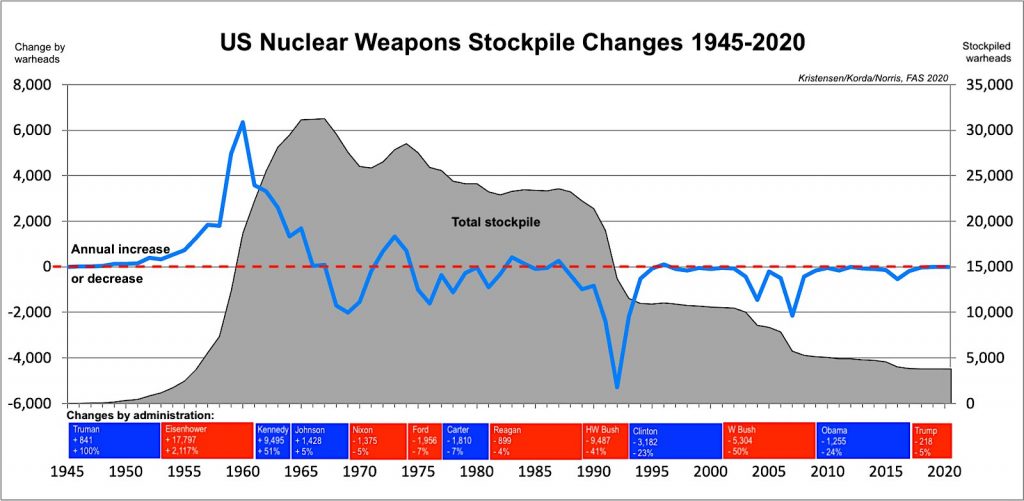
The size of the US nuclear weapons stockpile has fluctuated considerably over the years but remained relatively stable during the Trump administration. Click on image to view full size.
Implications and Recommendations
The decision by the Trump administration to deny declassification of the nuclear weapons stockpile size and dismantlement numbers contradict release of such data in the past for no apparent reason.
The increased secrecy of the US nuclear weapons arsenal comes at a time when the Trump administration has been criticizing China for “its secretive, nuclear crash buildup…” The administration’s criticism would carry a lot more weight if it didn’t hide its own stockpile behind a “great wall of secrecy.”
In addition to undercutting the US ability to push for greater transparency among other nuclear-armed states, the decision to classify warhead stockpile and dismantlement data also weakens the ability of the United States to demonstrate good faith on its efforts to continue to reduce its nuclear arsenal in the context of the upcoming review conference of the nuclear Non-Proliferation Treaty. The decision enables conspiracists to spread false rumors that the United States is secretly increasing its nuclear arsenal.
The incoming Biden administration should overturn the Trump administration’s excessive and counterproductive nuclear secrecy and restore transparency of the US nuclear warhead stockpile and dismantlement data.
Background Information:
This publication was made possible by generous contributions from the John D. and Catherine T. MacArthur Foundation, the New Land Foundation, the Ploughshares Fund, and the Prospect Hill Foundation. The statements made and views expressed are solely the responsibility of the authors.
Environmental Assessment Reveals New Details About the Air Force’s ICBM Replacement Plan
Any time a US federal agency proposes a major action that “has the potential to cause significant effects on the natural or human environment,” they must complete an Environmental Impact Statement, or EIS. An EIS typically addresses potential disruptions to water supplies, transportation, socioeconomics, geology, air quality, and other factors in great detail––meaning that one can usually learn a lot about the scale and scope of a federal program by examining its Environmental Impact Statement.
What does all this have to do with nuclear weapons, you ask?
Well, given that the Air Force’s current plan to modernize its intercontinental ballistic missile force involves upgrading hundreds of underground and aboveground facilities, it appears that these actions have been deemed sufficiently “disruptive” to trigger the production of an EIS.
To that end, the Air Force recently issued a Notice of Intent to begin the EIS process for its Ground-Based Strategic Deterrent (GBSD) program––the official name of the ICBM replacement program. Usually, this notice is coupled with the announcement of open public hearings, where locals can register questions or complaints with the scope of the program. These hearings can be influential; in the early 1980s, tremendous public opposition during the EIS hearings in Nevada and Utah ultimately contributed to the cancellation of the mobile MX missile concept. Unfortunately, in-person EIS hearings for the GBSD have been cancelled due to the ongoing Covid-19 pandemic; however, they’ve been replaced with something that might be even better.
The Air Force has substituted its in-person meetings for an uncharacteristically helpful and well-designed website––gbsdeis.com––where people can go to submit comments for EIS consideration (before November 13th!). But aside from the website being just a place for civic engagement and cute animal photos, it is also a wonderful repository for juicy––and sometimes new––details about the GBSD program itself.
The website includes detailed overviews of the GBSD-related work that will take place at the three deployment bases––F.E. Warren (located in Wyoming, but responsible for silos in Wyoming, Colorado, and Nebraska), Malmstrom (Montana), and Minot (North Dakota)––plus Hill Air Force Base in Utah (where maintenance and sustainment operations will take place), the Utah Test and Training Range (where missile storage, decommissioning, and disposal activities will take place), Camp Navajo in Arizona (where rocket boosters and motors will be stored), and Camp Guernsey in Wyoming (where additional training operations will take place).
Taking a closer look at these overviews offers some expanded details about where, when, and for how long GBSD-related construction will be taking place at each location.
For example, previous reporting seemed to indicate that all 450 Minuteman Launch Facilities (which contain the silos themselves) and “up to 45” Missile Alert Facilities (each of which consists of a buried and hardened Launch Control Center and associated above- or below-ground support buildings) would need to be upgraded to accommodate the GBSD. However, the GBSD EIS documents now seem to indicate that while all 450 Launch Facilities will be upgraded as expected, only eight of the 15 Missile Alert Facilities (MAF) per missile field would be “made like new,” while the remainder would be “dismantled and the real property would be disposed of.”
Currently, each Missile Alert Facility is responsible for a group of 10 Launch Facilities; however, the decision to only upgrade eight MAFs per wing––while dismantling the rest––could indicate that each MAF could be responsible for up to 18 or 19 separate Launch Facilities once GBSD becomes operational. If this is true, then this near-doubling of each MAF’s responsibilities could have implications for the future vulnerability of the ICBM force’s command and control systems.
The GBSD EIS website also offers a prospective construction timeline for these proposed upgrades. The website notes that it will take seven months to modernize each Launch Facility, and 12 months to modernize each Missile Alert Facility. Once construction begins, which could be as early as 2023, the Air Force has a very tight schedule in order to fully deploy the GBSD by 2036: they have to finish converting one Launch Facility per week for nine years. It is expected that construction and deployment will begin at F.E. Warren between 2023 and 2031, followed by Malmstrom between 2025 and 2033, and finally Minot between 2027 and 2036.
Although it is still unclear exactly what the new Missile Alert Facilities and Launch Facilities will look like, the EIS documents helpfully offer some glimpses of the GBSD-related construction that will take place at each of the three Air Force bases over the coming years.
In addition to the temporary workforce housing camps and construction staging areas that will be established for each missile wing, each base is expected to receive several new training, storage, and maintenance facilities. With a single exception––the construction of a new reentry system and reentry vehicle maintenance facility at Minot––all of the new facilities will be built outside of the existing Weapons Storage Areas, likely because these areas are expected to be replaced as well. As we reported in September, construction has already begun at F.E. Warren on a new underground Weapons Generation Facility to replace the existing Weapons Storage Area, and it is expected that similar upgrades are planned for the other ICBM bases.
Finally, the EIS documents also provide an overview of how and where Minuteman III disposal activities will take place. Upon removal from their silos, the Minutemen IIIs will be transported to their respective hosting bases––F.E. Warren, Malmstrom, or Minot––for temporary storage. They will then be transported to Hill Air Force Base, the Utah Test and Training Range (UTTR), or Camp Najavo, in Arizona. It is expected that the majority of the rocket motors will be stored at either Hill AFB or UTTR until their eventual destruction at UTTR, while non-motor components will be demilitarized and disposed of at Hill AFB. To that end, five new storage igloos and 11 new storage igloos will be constructed at Hill AFB and UTTR, respectively. If any rocket motors are stored at Camp Navajo, they will utilize existing storage facilities.
After the completion of public scoping on November 13th (during which anyone can submit comments to the Air Force via Google Form), the next public milestone for the GBSD’s EIS process will occur in spring 2022, when the Air Force will solicit public comments for their Draft EIS. When that draft is released, we should learn even more about the GBSD program, and particularly about how it impacts––and is impacted by––the surrounding environment. These particular aspects of the program are growing in significance, as it is becoming increasingly clear that the US nuclear deterrent––and particularly the ICBM fleet deployed across the Midwest––is uniquely vulnerable to climate catastrophe. Given that the GBSD program is expected to cost nearly $264 billion through 2075, Congress should reconsider whether it is an appropriate use of public funds to recapitalize on elements of the US nuclear arsenal that could ultimately be rendered ineffective by climate change.
Additional background information:
- United States nuclear forces, 2020
-
Construction of New Underground Nuclear Warhead Facility At Warren AFB
This publication was made possible by generous contributions from the Carnegie Corporation of New York, the John D. and Catherine T. MacArthur Foundation, the New Land Foundation, the Ploughshares Fund, and the Prospect Hill Foundation. The statements made and views expressed are solely the responsibility of the author.
Image sources: Air Force Global Strike Command. 2020. “Environmental Impact Statement for the Ground-Based Strategic Deterrent Deployment and Minuteman III Decommissioning and Disposal: Public Scoping Materials.”
The Nonproliferation and Disarmament Challenges of Naval Nuclear Propulsion
A so-called loophole might allow a non-nuclear weapon state (NNWS) to use a naval reactor program to acquire nuclear weapons by taking nuclear material outside of safeguards and then potentially diverting some of that material. Additionally, nuclear-armed states with nuclear-powered warships might use their naval reactor programs to justify keeping a substantial inventory of highly enriched uranium (HEU)3 that could be quickly converted to nuclear weapon use or low enriched uranium (LEU) that could also be converted, but with more steps required to boost the LEU to HEU. Recognizing these and related nonproliferation and disarmament challenges, this report presents a proposal for the 2020 Non-Proliferation Treaty (NPT) Review Conference: a naval reactor quid pro quo (QPQ) for nuclear- armed states4 and NPT non-nuclear weapon states.
Human Factors in Verifying Warhead Dismantlement
Arms control agreements that envision the verified dismantlement of nuclear weapons require the availability of suitable technology to perform the verification. But they also depend on the good faith of the participants and a shared sense of confidence in the integrity of the verification process.
An exercise in demonstrated warhead dismantlement showed that such confidence could be easily disrupted. The exercise, sponsored by the United States and the United Kingdom in 2010 and 2011, was described in a recent paper by Los Alamos scientists. See Review of the U.S.-U.K. Warhead Monitored Dismantlement Exercise by Danielle Kristin Hauck and Iain Russell, Los Alamos National Laboratory, August 4, 2016.
Participants played the roles of the host nation, whose weapons were to be dismantled, and of the monitoring nation, whose representatives were there to verify dismantlement. Confusion and friction soon developed because “the host and monitoring parties had different expectations,” the authors reported.
“The monitoring party did not expect to justify its reasons for performing certain authentication tasks or to justify its rationale for recommending whether a piece of equipment should or should not be used in the monitoring regime. However, the host party expected to have an equal stake in authentication activities, in part because improperly handled authentication activities could result in wrongful non-verification of the treaty.”
“Attempts by the host team to be involved in the authentication activities, and requests for justifications of monitoring party decisions felt intrusive and controlling. Monitoring party rebuffs to the host team reduced the host’s confidence in the sincerity of the monitoring party for cooperative monitoring.”
What emerged is that verified dismantlement of nuclear weapons is not simply a technical problem, though it is also that.
Seeking Verifiable Destruction of Nuclear Warheads
A longstanding conundrum surrounding efforts to negotiate reductions in nuclear arsenals is how to verify the physical destruction of nuclear warheads to the satisfaction of an opposing party without disclosing classified weapons design information. Now some potential new solutions to this challenge are emerging.
Based on tests that were conducted by the Atomic Energy Commission in the 1960s in a program known as Cloudgap, U.S. officials determined at that time that secure and verifiable weapon dismantlement through visual inspection, radiation detection or material assay was a difficult and possibly insurmountable problem.
“If the United States were to demonstrate the destruction of nuclear weapons in existing AEC facilities following the concept which was tested, many items of classified weapon design information would be revealed even at the lowest level of intrusion,” according to a 1969 report on Demonstrated Destruction of Nuclear Weapons.
But in a newly published paper, researchers said they had devised a method that should, in principle, resolve the conundrum.
“We present a mechanism in the form of an interactive proof system that can validate the structure and composition of an object, such as a nuclear warhead, to arbitrary precision without revealing either its structure or composition. We introduce a tomographic method that simultaneously resolves both the geometric and isotopic makeup of an object. We also introduce a method of protecting information using a provably secure cryptographic hash that does not rely on electronics or software. These techniques, when combined with a suitable protocol, constitute an interactive proof system that could reject hoax items and clear authentic warheads with excellent sensitivity in reasonably short measurement times,” the authors wrote.
See Physical cryptographic verification of nuclear warheads by R. Scott Kemp, et al,Proceedings of the National Academy of Sciences, published online July 18.
More simply put, it’s “the first unspoofable warhead verification system for disarmament treaties — and it keeps weapon secrets too!” tweeted Kemp.
See also reporting in Science Magazine, New Scientist, and Phys.org.
In another recent attempt to address the same problem, “we show the viability of a fundamentally new approach to nuclear warhead verification that incorporates a zero-knowledge protocol, which is designed in such a way that sensitive information is never measured and so does not need to be hidden. We interrogate submitted items with energetic neutrons, making, in effect, differential measurements of both neutron transmission and emission. Calculations for scenarios in which material is diverted from a test object show that a high degree of discrimination can be achieved while revealing zero information.”
See A zero-knowledge protocol for nuclear warhead verification by Alexander Glaser, et al, Nature, 26 June 2014.
But the technology of nuclear disarmament and the politics of it are two different things.
For its part, the U.S. Department of Defense appears to see little prospect for significant negotiated nuclear reductions. In fact, at least for planning purposes, the Pentagon foresees an increasingly nuclear-armed world in decades to come.
A new DoD study of the Joint Operational Environment in the year 2035 avers that:
“The foundation for U.S. survival in a world of nuclear states is the credible capability to hold other nuclear great powers at risk, which will be complicated by the emergence of more capable, survivable, and numerous competitor nuclear forces. Therefore, the future Joint Force must be prepared to conduct National Strategic Deterrence. This includes leveraging layered missile defenses to complicate adversary nuclear planning; fielding U.S. nuclear forces capable of threatening the leadership, military forces, and industrial and economic assets of potential adversaries; and demonstrating the readiness of these forces through exercises and other flexible deterrent operations.”
See The Joint Operating Environment (JOE) 2035: The Joint Force in a Contested and Disordered World, Joint Chiefs of Staff, 14 July 2016.
Mind the Empathy Gap
Here is some news from recent research in neuroscience that, I think, is relevant for FAS’s mission to prevent global catastrophes. Psychologists Dacher Keltner of the University of California, Berkeley, and Jonathan Haidt of New York University, have argued that feelings of awe can motivate people to work cooperatively to improve the collective good.1Awe can be induced through transcendent activities such as celebrations, dance, musical festivals, and religious gatherings. Prof. Keltner and Prof. Paul Piff of the University of California, Irvine, recently wrote in an opinion article for the New York Times that “awe might help shift our focus from our narrow self-interest to the interests of the group to which we belong.”2 They report that a forthcoming peer reviewed article of theirs in the Journal of Personality and Social Psychology, “provides strong empirical evidence for this claim.”
Their research team did surveys and experiments to determine whether participants who said they experienced awe in their lives regularly would be more inclined to help others. For example, one study at UC, Berkeley, was conducted near a spectacular grove of beautiful, tall Tasmanian blue gum eucalyptus trees. The researchers had participants either look at the trees or stare at the wall of the nearby science building for one minute. Then, the researchers arranged for “a minor accident” to occur in which someone walking by would drop a handful of pens. “Participants who had spent the minute looking up at the tall trees—not long, but long enough, we found, to be filled with awe—picked up more pens to help the other person.”
Piff and Keltner conclude their opinion piece by surmising that society is awe-deprived because people “have become more individualistic, more self-focused, more materialistic and less connected to others.” My take away is that this observation has ramifications for whether people will band together to tackle the really tough problems confronting humanity including: countering and adapting to climate change, alleviating global poverty, and preventing the use of nuclear weapons. I find it interesting that Professors Piff and Keltner have mentioned shifting individuals’ interest to the group to which those people belong.
What about bringing together “in groups” with “out groups”? Can awe help or harm? Here’s where, I believe, the geopolitical and neuroscience news is mixed. First, let’s look at the bad news and then finish on a positive message of recent psychological research showing interventions that might alleviate the animosity between groups who are in conflict.
While awe can be inspiring, a negative connotation toward out groups is implicit in the phrase “shock and awe” in the context of massive demonstration of military force to try to influence the opponent to not resist the dominant group. Many readers will recall attempted use of this concept in the U.S.-led military campaign against Iraq in March and April 2003. U.S. and allied forces moved rapidly with a demonstration of impressive military might in order to demoralize Iraqi forces and thus result in a quick surrender. While Baghdad’s political power center crumbled quickly, many Iraqi troops dispersed and formed the nuclei of the insurgency that then opposed the occupation for many years to come.3 Thus, in effect, the frightening awe of the invasion induced numerous Iraqis to band together to resist U.S. forces rather than universally shower American troops with garlands.
Nuclear weapons are also meant to shock and awe an opponent. But the opponent does not have to be cowed into submission. To deter this coercive power, the leader of a nation under nuclear threat can either decide to acquire nuclear weapons or form an alliance with a friendly nation that already has these weapons. Other nations that do not feel directly threatened by another nation’s nuclear weapons can ignore these threats and tend to other priorities. This describes the world we live in today. Most of the world’s nations in Central Asia, Latin America, Africa, and Southeast Asia are in nuclear-weapon-free-zones and have opted out of nuclear confrontations. But in many countries in Europe, North America, East Asia, South Asia, and increasingly the Middle East, nuclear weapons have influenced decision makers to get their own weapons and increase reliance on them (for example, China, North Korea, Pakistan, and Russia), acquire a latent capability to make these weapons (for example, Iran), or request and receive protection from nuclear-armed allies (for example, non-nuclear countries of NATO, Japan and South Korea).
Is this part of the world destined to always figuratively sit on a powder keg with a short fuse? Perhaps if people in these countries can close the empathy gap, they might reduce the risk of nuclear war and eventually find cooperative security measures that do not require nuclear weapons. Empathy is the ability to understand and share the feelings of others. Empathy is a natural human capacity especially when dealing with people who share many common bonds.
If we can truly understand someone we now perceive to be an enemy, would we be less likely to want to do harm to that person or other members of his or her group? Empathic understanding between groups is not a guarantee of conflict prevention, but it does appear to offer a promising method for conflict reduction. However, as psychological research has shown, failures of empathy often occur between groups that are socially or culturally different. People in one group can also feel pleasure in the suffering of those in the different group, especially if that other group is dominant. The German word schadenfreude captures this delight in others’ suffering. Competitive groups especially exhibit schadenfreude; for example, Boston Red Sox fans experience glee when the usually dominant New York Yankees lose to a weaker opponent.4
Are there interventions that can disrupt this negative behavior and feelings? Cognitive scientists Mina Cikara, Emile Bruneau and Rebecca Saxe point out that “historical asymmetries of status and power between groups” is a key variable.5 If the same intervention method such as asking participants to take the perspective of the other into account is used for both groups, different effects are observed. For example, the dominant group tends to respond most positively to perspective taking in which members of that group would listen attentively to the perspective or views of the other group. A positive response means that people’s attitude toward the other group becomes favorable. In contrast, the non-dominant group’s members often experience a deepening of negative attitudes toward the dominant group if they engage in perspective taking. Rather, members of the non-dominant group show a favorable change in attitude when they perform perspective giving toward the dominant group. Importantly, they have to know that members of the dominant group are being attentive and really listening to the non-dominant group’s perspective. In other words, the group with less or no political power needs to be heard for positive change to occur. While these results seem to be common sense, Bruneau and Saxe point out that almost always perspective taking is used in interventions intended to bring asymmetric groups together and often this conflict resolution method fails. Their research underscores the importance of perspective giving, especially for non-dominant groups.6
This research shows promising results that could have implications for bridging the divide between Americans and Iranians on the different views on nuclear power, for example, or the gap between Americans and Chinese on the implications of the U.S. pivot toward East Asia and the Chinese rise in economic, military, and political power. I conclude this president’s message with encouragement to cognitive scientists in the United States and other nations to apply these and other research techniques to the grand social challenges such as how to get people across the globe to work together to mitigate the effects of climate change and to achieve nuclear disarmament through cooperative security.
New Releases from the National Declassification Center
The National Declassification Center at the National Archives yesterday announced the availability of 240 sets of records that have recently undergone declassification processing.
Many of the record collections are listed in such banal or generic terms that it is hard to imagine they would attract any interest at all. (“Bureau of Naval Personnel Activity File, Personnel Accounting Ledger Records, 1952-1967”?)
But there are also a few items that will make at least some researchers’ hearts beat a little faster, such as three boxes of declassified “Cloud Gap Field Test Reports, 1962-69.”
Cloud Gap was an ambitious government project in the 1960s to establish the technical basis for new arms control measures. Previously disclosed Cloud Gap Field Test Reports on the verifiable dismantlement of nuclear weapons are posted here.
Recommendations for the U.S. Delegation to the NPT Review Conference
The Nuclear Non-Proliferation Treaty (NPT) has endured as the cornerstone of the non-proliferation regime and remains the only legally binding multilateral agreement on nuclear disarmament. In May 2010, the NPT Review Conference met at the United Nations and provided a critical opportunity to advance the vision President Obama laid out of a world free of nuclear weapons.
Missions for Nuclear Weapons after the Cold War
This report (PDF) examines currently proposed nuclear missions and finds that the United States is witnessing the end of a long process of having nuclear weapons be displaced by advanced conventional alternatives.
The most challenging nuclear mission is a holdover from the Cold War: to be able to carry out a disarming first strike against Russian central nuclear forces. Only if the US and Russia abandon this mission will meaningful reductions in the two largest arsenals be possible.
